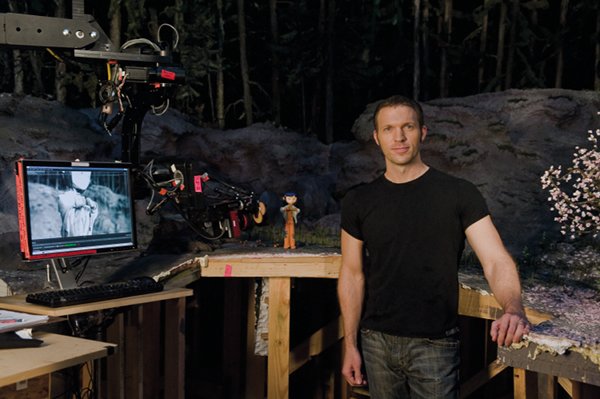Almost exactly one year ago, Laika’s first feature film, Coraline, made its world-wide debut in downtown Portland. Now comes the news that this dark but endearing work of stop-action animation has been nominated for an Academy Award, launching a small, independent Oregon studio with a 36-year-old CEO into the big-leagues with Disney, Pixar and DreamWorks.
This is excellent news for Oregon’s film industry and a validation for the father-son tandem of Laika chairman Phil Knight and CEO Travis Knight. They took bold risks on Coraline, financially and artistically, and their risks are being rewarded. The film has already grossed more than $120 million (twice what it cost to make), and the publicity and gravitas of an Oscar nomination will boost sales as Coraline hits theaters in animation-crazy Japan and tackles the DVD and paid-television markets domestically.
“Five years ago when we were trying to find a partner for Coraline, nobody had heard of us,” CEO Travis Knight told me yesterday afternoon. “Obviously that changes with this nomination. This will make things easier for the business. But it also increases pressure on us creatively. We’ve set the bar high for what we’re capable of doing and we’ve got to live up to that now.”
Almost exactly one year ago, Laika’s first feature film, Coraline, made its world-wide debut in downtown Portland. Now comes the news that this dark but endearing work of stop-action animation has been nominated for an Academy Award, launching a small, Oregon studio with a 36-year-old CEO into the big-leagues with Disney, Pixar and DreamWorks.
 This is excellent news for Oregon’s film industry and a validation for the father-son tandem of Laika chairman Phil Knight and CEO Travis Knight. They took bold risks on Coraline, financially and artistically, and their risks are being rewarded. The film has already grossed more than $120 million (twice what it cost to make), and the publicity and gravitas of an Oscar nomination will boost sales as Coraline hits theaters in animation-crazy Japan and tackles the DVD and paid-television markets domestically.
This is excellent news for Oregon’s film industry and a validation for the father-son tandem of Laika chairman Phil Knight and CEO Travis Knight. They took bold risks on Coraline, financially and artistically, and their risks are being rewarded. The film has already grossed more than $120 million (twice what it cost to make), and the publicity and gravitas of an Oscar nomination will boost sales as Coraline hits theaters in animation-crazy Japan and tackles the DVD and paid-television markets domestically.
“Five years ago when we were trying to find a partner for Coraline, nobody had heard of us,” CEO Travis Knight told me yesterday afternoon. “Obviously that changes with this nomination. This will make things easier for the business. But it also increases pressure on us creatively. We’ve set the bar high for what we’re capable of doing and we’ve got to live up to that now.”
So what is next for Laika? A report by Jennifer Netherby in our April 2009 issue identified a few possiblities, including Here Be Monsters!, about a 12-year-old boy who lives underground in 1850s London, and Paranorman, an original idea from Laika story chief Chris Butler about a cursed small town that can only be saved by a 13-year-old boy. But Knight won’t give any clues about which project is the front-runner.
“I’m not quite prepared to say,” says Knight. “But we have put our next film in pre-production and we anticipate going into production earlier this year. We’re looking to make an announcement in a couple of months. We should see the light of day in the marketplace in a couple of years.”
That’s encouraging. The company employs 200 people, about half of whom work on animated commercials for the likes of McDonald’s, Tostitos salsa, M&Ms and Spam (that’s right, the canned meat product). Knight says Laika will add “hundreds” of jobs once production begins on the next full-length feature.
That growth may seem overdue to the impatient among us, but it has never been a sure thing for Laika. For all of the critical acclaim associated with Coraline, it’s been a challenging run for Laika as a business, with several mass layoffs, the slow and painful death of Jack and Ben’s Animated Adventure, and the abrupt departure of Coraline director Henry Selick last October.
 “Every day is a new adventure,” says Knight. “It was indeed a year of extremes, from the euphoria of the Coraline release to some of the struggles we’ve had in trying to organize our business, and now back to euphoria again. It really has been one thing after another. We are a young company and we are evolving and growing and, one would hope, maturing.”
“Every day is a new adventure,” says Knight. “It was indeed a year of extremes, from the euphoria of the Coraline release to some of the struggles we’ve had in trying to organize our business, and now back to euphoria again. It really has been one thing after another. We are a young company and we are evolving and growing and, one would hope, maturing.”
Knight credits Laika’s new CFO, former DreamWorks executive Gary Raksis, with bringing new stability to the leadership team. But he insists that financial pressures will not cause Laika to stop taking creative risks. Laika specializes in stop motion animation, a labor intensive and potentially outdated art form, and it chose an unusually bleak work of fiction for its first feature length film. An unusual strategy perhaps, but it worked. Knight, who fought hard for Coraline and served as the film’s lead animator, says he has no plans to change that approach .
“The biggest risk would be to try to do something safe,” says Knight. “Any company that tries to follow what Pixar has done or what DreamWorks has done is chasing a ghost because those companies are always evolving. It’s very important to us to make films that resonate with people, but we’re not interested in making pop culture confections or ephemera. We do want to tap into the zeitgeist but we don’t want to make things that are temporary and fleeting. We want to make films that are bold and distinctive and enduring.”
An Oscar nomination grants Knight and his team creative license to do just that. It’s the best boost Oregon’s film industry has gotten since a year ago, when Coraline first hit the big screen.
UPDATE (Feb. 8): Laika led all studios with ten nominations for this year’s Annie Awards, for excellence in animation. The studio took home three first-place awards in all: Shane Prigmore, for character design, Bruno Coulais, for music composition and Tadahiro Uesugi, for production design.
Ben Jacklet is Managing Editor of Oregon Business.


